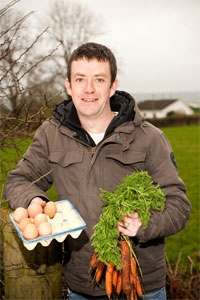Grow It Yourself - December
I can’t confess to know a lot about beekeeping. Actually, correct that, I know absolutely nothing about beekeeping. So, one might be surprised to find a beehive in my garden. But there it is nonetheless, nestling happily in a secluded patch between my polytunnel and the hedgerow.
The fact that I have a beehive in my garden is the result of a strange confluence of fortuitous events. A beekeeper from Waterford city, Mike Hughes, with a lifetime’s beekeeping expertise, who needed somewhere to put a hive. And a honey lover (i.e. me) who has zero knowledge and plenty of space for a hive.
The arrangement is therefore a symbiotic one but (don’t tell Mike) I think I get far more out of it then he does. He shows up occasionally to check in on the bees, and at the end of the season I buy the jars of honey off him, with some basic beekeeping tuition thrown in for free.
The noise of their buzzing provides a welcome backdrop as I work in the veg patch and polytunnel, and of course they are great pollinators for flowering plants such as tomatoes in the tunnel and elsewhere in the garden.
The Food and Agriculture Organisation of the United Nations estimates that of the 100 crop varieties that provide 90 per cent of food worldwide, 71 rely to some extent on bee pollination. So in other words, the unassuming little bee is actually maintaining life on this planet - no bees, no pollination. No pollination, no food. No food, no humans. And make no mistake, bees are under threat: from the gradual disappearance of their natural habitats, the use of pesticides and the parasitic varroa mite which has killed off 30% of bees in Europe (and the entire wild bee population in Ireland).
So, experienced beekeepers like Mike, are a valuable commodity indeed. There are roughly 2,500 beekeepers in Ireland according to the Federation of Irish Beekeepers Association. The organisation has 53 local member associations, each of which has its own programmes of lectures and demonstrations trying to encourage more people to get involved. Check out www.irishbeekeeping.ie.
Things to Do this Month - December
As you clear remaining crops from your veggie patch, dig the beds over and add well rotted compost or manure. Get Educated – book yourself on a course! Start planning what you would like to grow next year and work out what crop rotation system you are going to use. Study seed catalogues carefully before deciding on the best varieties to grow. Start a Compost corner or heap. Keep an eye on your stored veggies and discard anything that’s rotting. Collect and store leaves in bags to make leaf mould or use as cover for bare soil.
Sow
If you haven’t already done so plant garlic – it should be in the soil by the shortest day of the year. Bring herbs like mint, chives, lemon balm, parsley, thyme indoors by lifting and potting them up.
Harvest
Buck the seasonal trend by continuing to harvest winter salad leaves like corn salad, land cress and mizuna. You should still have at least some produce left in the December veggie patch e.g. winter cabbages, Brussels sprouts, leeks, kale, Jerusalem artichokes, carrots, celery, turnips, parsnips, winter cauliflowers, swedes, spinach, chard and celeriac. From your stores you can enjoy pumpkins and squashes, potatoes, onions, apples, beetroot and garlic.
Recipe of the Month – Root Veg Pie
I’m really in to warming, root-based, one-pot dishes at the moment and this is a delicious and healthy pie that will utilize vegetables that are still available in the December vegetable patch (or larder) like carrots, celeriac and squash. It’s one I return to again and again at this time of year. You don’t need to stick too slavishly to the recipe – use whatever root crops you have and experiment. You can leave out the pepper if you want (it’s not likely to be seasonal).
Ingredients:
• 1 quantity short crust pastry – 350g
• 300g potatoes
• 300g celeriac
• 300g squash or pumpkin
• 4 medium mushrooms
• 1 red pepper
• 2 tablespoons olive oil
• 2 tablespoons chopped rosemary
• 300g fresh ricotta (I’ve used feta too and it’s lovely)
• ¾ cup grated cheddar or goats cheese
• ½ cup grated parmesan
Directions:
Preheat the oven to 180 degrees Celsius. To the make the filling place the potato, celeriac, pumpkin, mushrooms and pepper in a baking dish and toss with the oil and rosemary – season well. Bake for 30 minutes until golden. Leave to cool. Roll out the pastry and use it to line a pie dish, trimming away the excess. Mix the vegetables with the ricotta and cheddar, and then fill the pie dish. Sprinkle the parmesan over it. Bake for 35 minutes until the pie is golden. Serves 4.
Tip of the Month – Start Harvesting Early Sprouts
Early maturing sprout varieties are now cropping. Pick sprouts as soon as they are ready to eat (while still hard and firm and before they open out). Pick the sprouts from the bottom of the stem first and then move upwards. To harvest a sprout simply snap off by pulling downwards. The leaves at the top of the stems can be cooked like spring greens – very tasty they are too. For more information on sowing, growing and harvesting sprouts check out the GIY Veg Directory at www.giyireland.com.
 About GIY
About GIY
GIY is a not-for-profit organisation that aims to create a healthier, more sustainable world where people grow their own food. We inspire and support people to grow food more successfully by bringing them together to share advice, tips and ideas. There are approximately 50,000 people involved in the GIY movement in Ireland.
For more information check out www.giyireland.com
Michael Kelly is a freelance journalist, author and founder of GIY Ireland.
© GIY Ireland 2013 – all rights reserved.







There are currently no comments
Leave a comment
Not a member? Register for your free membership now!
Or leave a comment by logging in with: